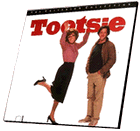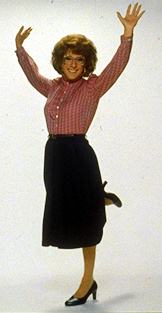

USA comedy
1982
color 116 min.
Director: Sydney Pollack
CAV: out-of-print collectible
2 discs, catalog # CC1264L
CLV: $39.95 - available
1 disc, catalog # CC1323L

When
Tootsie opened in December, 1982, the ad copy read: "In the
next 72 hours this desperate, unemployed actor will secretly audition
for the female lead of a soap opera." That was the plot line to the
movie even when it was just a 30-page treatment, "Calling Diana
Darling," by veteran screenwriter Don McGuire (who had worked on three
early Jerry Lewis movies and cowrote Bad Day at Black
Rock). From 1975, when McGuire handed his treatment to
agent-producer Martin Baum, until shooting started in 1982, the movie
went through five production executives and an allstar team of
screenwriters -- while retaining the same story. In a sense, it's a
triumph of Hollywood collaboration.Back in 1975, Baum, hoping to
co-produce the comedy with McGuire, commissioned him to write a
138-page first draft called "Would I Lie to You?" The team offered it
to Peter Sellers and Michael Caine, "and a lot of guys," says McGuire,
but they "couldn't quite get it together." Then Cine-Artists
International took over the project while McGuire and Baum moved on
(McGuire retained part-ownership). Cine-Artists hoped to star George
Hamilton and Buddy Hackett, but, says McGuire, "Everything went
kaplooey."
Over the next two years, McGuire would get calls from "a
half-dozen hustlers" and refer them to Cine-Artists. Then, in 1978, a
lawyer for Charles Evans, brother of producer Robert Evans, called
McGuire to set up a deal. Evans hired Robert Kaufman (Getting
Straight, Love at First Bite) to do a rewrite, with George
Hamilton (once again) as the prospective star. Next, Evans signed Dick
Richards, who directed the cult comedy Rafferty and the Gold Dust
Twins.
Soon after, McGuire would read in the trade paper
Variety that Dustin Hoffman was set to star in McGuire's
project, now called Tootsie.
It was Richards who brought
Hoffman into the production after Kaufman and Hamilton bowed out
(according to Kaufman, the reason was "creative differences" with the
producer). Hoffman brought in his best friend, Murray Schisgal, to do
another rewrite. The setting changed from the West Coast to the New
York theater scene, and the lead character grew extraordinarily close
to Hoffman's own persona as the driven, perfectionist actor
perpetually clashing with his co-workers. "I've known Dustin for
twenty years," says Schisgal, "since he was an actor Off-Broadway,
Off-Off-Broadway. That scene (in Tootsie) where the actor won't
move to the center of the stage because the character, Tolstoy, is
dying? That's the way Dusty was."
Despite Schisgal's contributions,
the project remained at an impasse. Dick Richards left to do Erich
Segal's Man,Woman and Child. Hal Ashby nearly took his
place. Then agent Michael Ovitz and Columbia Pictures, for whom
Hoffman had done Kramer vs. Kramer, put him together with
director Sydney Pollack, one of the studio's most consistent
moneymakers (The Way We Were, The Electric Horseman).
Pollack wanted to work with Hoffman, but only if they could straighten
out the script to everyone's satisfaction.
Pollack says the
structure of Tootsie was hammered out over a two-week trial
period by himself, Hoffman, and the new screenwriter, Larry Gelbart,
one of the industry's most reliable comedy writers (Movie
Movie, Broadway's A Funny Thing Happened on the Way to the
Forum, TV's M*A*S*H). Other unbilled writers who
contributed to the final script included Elaine May, Valerie Curtin
and Barry Levinson; even Bill Murray rewrote most of his own lines.
Says Pollack, "Then Levinson and Curtin came on one week into shooting
to help smooth it out. They didn't do much writing. By that time the
film was already on a railroad track. They did help remove a
stumbling block in the plot: how Dustin would get in bed with Teri
Garr. Levinson and Curtin had Teri emerge from her shower while
Hoffman's undressing because he wants 'Dorothy' to try on Teri's
clothes."
If he had been handed a perfect script, Pollack's major
contributions to Tootsie would have been mood, tone,
embellishment. Instead, he also had to assume the demanding task of
managing editor. Most of all, Pollack gave the film a unifying
sensibility.
"People were always telling me, 'You don't want to make
an outrageous comedy, you want to make a gentle love story," says
Pollack. "And they were right. I wish I could say that was coming out
of some great artistic instinct. But in fact it was coming from
self-defense. I am not a farceur. I know better than to go into an
area where I don't know the rules. Some self-protective instinct told
me, 'Stay rooted in a literal reality.' So when it got too extreme, I
would say, 'I don't believe that.' What I meant was, 'I don't have the
equipment to direct that.' Blake Edwards could do that, Billy Wilder
could do that. But I've got to go another way. And I did."
--
MICHAEL SRAGOW
Credits
Director: Sydney
Pollack
Producers: Sydney Pollack, Dick Richards
Screenplay:
Larry Gelbart, Murray Schisgal
Story by: Don McGuire, Larry
Gelbart
Director of Photography: Owen Roizman, A.S.C.
Production
Design: Peter Larkin
Executive Producer: Charles Evans
Editors:
Fredric Steinkamp, William Steinkamp
Original Songs, Lyrics: Alan
& Marilyn Bergman
Music by: Dave Grusin
Costumes Designed by:
Ruth Morley
Casting by: Lynn Stalmaster, Toni Howard &
Associates
"Tootsie" & "It Might Be You" sung by: Stephen
Bishop
Transfer
This edition of Tootsie was
transferred digitally from a 35mm interpositive in its original aspect
ratio of 2.35:1. The soundtrack was mastered from a 35mm magnetic
soundtrack.






